Getting Started with Gather
Do you need help installing or updating Gather?
If you’d like to start with some example content, here’s the content from the demo. Download and unzip the file. Then use the Tools → Import tool in your WordPress admin. Need step by step directions?
Before importing Gather demo content, be sure to have the WooCommerce plugin installed and activated. If you are experiencing a problem with duplicate pages, import the demo content before installing the WooCommerce pages.
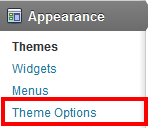 In your WordPress admin, click on the “Theme Options” button located under the “Appearance” tab in the left menu. Here you can configure a number of options to tailor the theme to fit your needs.
In your WordPress admin, click on the “Theme Options” button located under the “Appearance” tab in the left menu. Here you can configure a number of options to tailor the theme to fit your needs.
General
Logo: Upload your own personal logo. If no logo is uploaded, your website’s name will be displayed in
plain text.
Favicon: Add your own favicon.
Custom CSS: Add your own custom styles.
Appearance
Here you can control the colors of vaious elements in the theme, and upload a background pattern for the home page slideshow area.
Typography
Specify fonts from Google’s Web Font Directory for headings, body text, and home message. Be sure to type the font name exactly as it is listed on their site.
Home Page
Here you can control various aspects of the home page, such as the home page message, number of recent projects to show, etc.
Posts
Control what information is shown with posts and the size of the post’s featured image.
Footer
Enter text that will be displayed in the footer.
Integration
Add your analytics code.
Slideshow
Control the speed and the effect of the slideshows generated from the slideshow shortcode.
In your WordPress admin, click on “Menus”, which is located uner the “Appearance” tab on the left. Start by creaing a new menu in the panel on the right. Once the new menu is created you can add pages, categories, and custom links from the panels on the left. You can then re-order and create submenus by dragging the menu items. When you’re finished, click the “Save Menu” button.
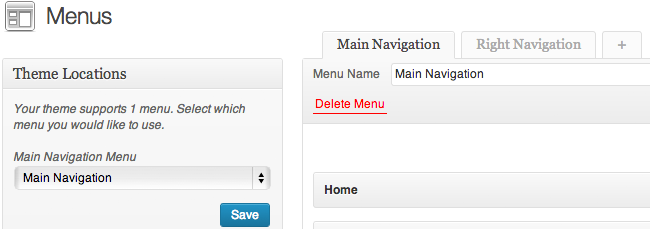
This theme has several custom widgets and a number of widgetized areas in which you can use them. To add widgets, click on “Widgets” under the “Appearance” tab in your WordPress admin. Click and drag a widget to one of the boxes on the right. Then set your options for that widget.
Custom Widgets
Gather Recent Posts: Display a list of recent posts from a certain category or all categories, with the option to display an excerpt from the most recent post.
Gather Flickr: Show thumbnails for a Flickr account. Please note the Flickr widget uses your ID not your username. If you don’t know it, visit here.
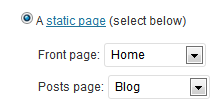 By default, this theme will display your latest posts on the front page. To activate the home page as seen in the demo, first create a new page and name it something like “Home”. As you’re creating this page, select the “Home” page template in the Page Attributes box found in the right column. After you publish your page, go to Settings → Reading. For “Front page displays”, choose a static page and select your newly created “Home” page. Then save your settings.
By default, this theme will display your latest posts on the front page. To activate the home page as seen in the demo, first create a new page and name it something like “Home”. As you’re creating this page, select the “Home” page template in the Page Attributes box found in the right column. After you publish your page, go to Settings → Reading. For “Front page displays”, choose a static page and select your newly created “Home” page. Then save your settings.
The Home Page template is set up to display a slideshow (see below), a home page message (configured in the theme options), your recent products (see Setting Up the Store), and static content.
Home Page Slideshow
This theme has a slideshow that you can display on the home page. You can enable and disable it in Appearance → Theme Options under the Home Page tab.
 You can add and manage slides under the “Slides” tab in the main WordPress admin menu. By default, slides are made up of a Title, image, and description. The recommended image size for the slides is: 1000px x 365px. Images are inserted into the main content area.
You can add and manage slides under the “Slides” tab in the main WordPress admin menu. By default, slides are made up of a Title, image, and description. The recommended image size for the slides is: 1000px x 365px. Images are inserted into the main content area.
To utilize the store features that are built into Gather, you will need to install a free plugin: WooCommerce. To do an automatic install of WooCommerce, log in to your WordPress admin panel, navigate to the Plugins menu and click Add New. In the search field type “WooCommerce” and click Search Plugins. Once you’ve found our eCommerce plugin you can view details about it such as the the point release, rating and description. Most importantly of course, you can install it by simply clicking Install Now. After clicking that link you will be asked if you’re sure you want to install the plugin. Click yes and WordPress will automatically complete the installation.
To view the extensive WooCommerce Codex, documentation and tips go to the WooCommerce Docs site.
We’re happy to help you in the support forum with basic questions about setting up your theme with WooCommerce. If you get stuck with WooCommerce itself, you can ask for help on the WooCommerce Community Forums
Adding Slideshows to Single Products
Image attachments are automatically setup as a slideshow. This means all you need to do is upload the images and save your changes – no shortcode is necessary.
Setting Number of Products on Store Page
To customize the number of products that appear in the store page, go to Settings > Reading and change the number for “Blog pages show at most”.
 If you’ve followed the steps above to set up your home page, you’ll probably want to display your posts on a different page. You can easily do this by creating a new page and giving it a name like “Blog”, “News”, or whatever you’d like to call it. After you publish your page, go to Settings → Reading. For “Front page displays”, choose your newly created “Blog” page for Posts page. Then save your settings.
If you’ve followed the steps above to set up your home page, you’ll probably want to display your posts on a different page. You can easily do this by creating a new page and giving it a name like “Blog”, “News”, or whatever you’d like to call it. After you publish your page, go to Settings → Reading. For “Front page displays”, choose your newly created “Blog” page for Posts page. Then save your settings.
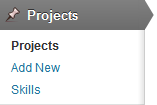 This theme uses a custom post type called “Projects” to help you manage your portfolio. You can use the “Portfolio” page template to display your projects on a page page. To add a new portfolio piece, select “Add New” under “Projects” in the left hand menu. Use the main text editor on the Project edit page to insert the main images or video for your project. Ideal image width is 960px, but if your images are larger they will be sized with the fluid layout.
This theme uses a custom post type called “Projects” to help you manage your portfolio. You can use the “Portfolio” page template to display your projects on a page page. To add a new portfolio piece, select “Add New” under “Projects” in the left hand menu. Use the main text editor on the Project edit page to insert the main images or video for your project. Ideal image width is 960px, but if your images are larger they will be sized with the fluid layout.
Skills
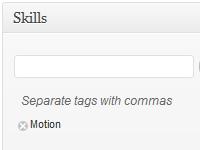 When creating a project, it’s important to assign it to a skill. Skills are categories for your projects and they are used to form the project filter navigation. You can find the “Skills” box in the right column.
When creating a project, it’s important to assign it to a skill. Skills are categories for your projects and they are used to form the project filter navigation. You can find the “Skills” box in the right column.
Project Options
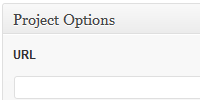 Here you can set an external link to your project. For example, if your project is a website hosted elsewhere.
Here you can set an external link to your project. For example, if your project is a website hosted elsewhere.
Thumbnail Image
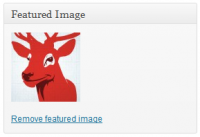 To create the thumbnail for your project, use the “Featured Image” box found at the bottom of the right column. Use the popup window to upload an image, and then click “Use as featured image”. The image that you upload should be at least 300px by 175px.
To create the thumbnail for your project, use the “Featured Image” box found at the bottom of the right column. Use the popup window to upload an image, and then click “Use as featured image”. The image that you upload should be at least 300px by 175px.
You can add beautiful buttons to the content of any page, post, or widget using the following shortcode:
[ssc][button url="http://themetrust.com/" target="_blank" label="Learn More"][/ssc]
The button shortcode takes 3 parameters: url, target, and label.
This theme comes with a special slideshow built-in that scales with the fluid layout which is all part of the responsive design. All you have to do to turn a set of images in your content into a slideshow is wrap them in this shortcode:
[ssc][slideshow][/slideshow][/ssc]
See the example below:
[ssc][slideshow] <img src="http://domain/imageurl-1.jpg" /> <img src="http://domain/imageurl-2.jpg" /> [/slideshow][/ssc]
It’s important to note that images in a slideshow can not be linked.
This theme comes with column shortcodes, which allows you to easily create columns within your content. You can create columns that are one third, two thirds, or one half of the content area’s width. Here’s an example. Notice the additon of “_last” to the name of the last column’s shorcode. This is important.
[ssc][one_third] ...your content here [/one_third] [one_third] ...your content here [/one_third] [one_third_last] ...your content here [/one_third_last][/ssc]
Here are the available column shortcodes: one_third, two_third, one_half. Use these in the format demonstrated above.
